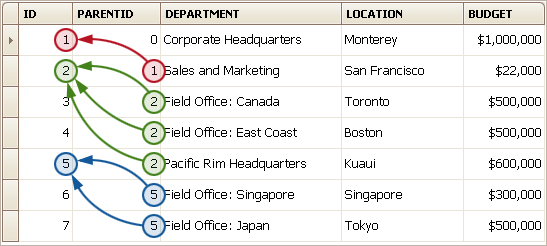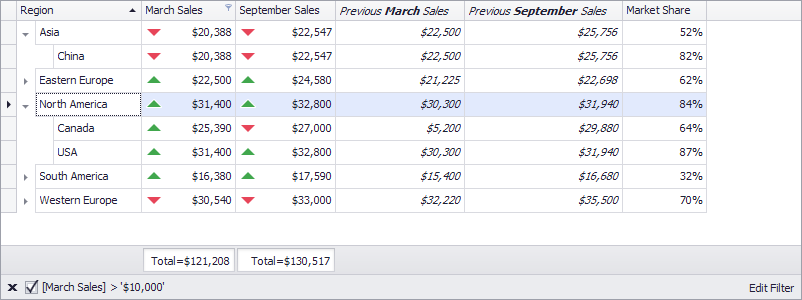Tree Generation Algorithm in the Tree List
- 12 minutes to read
The Tree List control displays hierarchical data structures in which nodes can have other nodes as children. This topic shows how to define the parent-child relationship at data source level for Tree List controls in bound mode.
Parent-Child Relationships
The data source bound to the Tree List control requires two additional fields:
- Key Field - This field contains unique values that identify records in the data source. Assign this field name to the TreeList.KeyFieldName property.
- Parent Field - This field refers to a corresponding parent node’s Key Field. Assign this field name to the TreeList.ParentFieldName property
The image below is an example of a data source with an ID column that contains Key Fields. The PARENTID column values are Parent Fields, which identify parent rows.

The following image shows the same data source bound to the Tree List control. The TreeList.KeyFieldName property is set to “ID” and the TreeList.ParentFieldName property to “PARENTID”.

Root Nodes
Root nodes are parentless (for example, the “Corporate Headquarters” node in the image above). All root nodes must have their Parent Field values (TreeList.ParentFieldName) set to TreeList.RootValue (by default, 0).
A parentless node whose Parent Field value does not match TreeList.RootValue is also recognized as a root node. If the Tree List control contains these parentless nodes, the control re-builds the hierarchy tree in many cases (for example, when data is updated or sorted). You may notice flickering and unexpected scroll behavior. To avoid these issues, we suggest that you always sync Parent Field values with TreeList.RootValue for root nodes.
Important
The RootValue property and values in the KeyFieldName and ParentFieldName fields must be of the same type.
Related API
- TreeList.KeyFieldName - Gets or sets the name of the key field that uniquely identifies records in the data source.
- TreeList.ParentFieldName - Gets or sets the data source field that identifies each record’s parent.
- TreeList.RootValue - Gets or sets the value that identifies root records in the data source. The root records must have the
RootValuein the field the ParentFieldName property specifies. - TreeListOptionsBehavior.PopulateServiceColumns - Gets or sets whether the TreeList.PopulateColumns method creates columns bound to the fields the TreeList.KeyFieldName, TreeList.ParentFieldName and TreeList.ImageIndexFieldName properties specify.
Example
The following example creates a TreeList at runtime and shows how to perform basic customization tasks:
- Bind the treelist to a data source
- Specify the key fields that form a hierarchy
- Access automatically created columns
- Set a custom row height
- Customize column captions (using HTML tags) and cell appearance settings
- Create unbound columns and create Excel-style format conditions based on these column values
- Assign an in-place editor (a spin editor) to columns
- Sort data
- Calculate total summaries
- Filter nodes
- Hide columns and calculate column “best” widths
- Locate and expand nodes
- Focus a specific cell
- Specify DataAnnotation attributes at the data source level (the “p0” display format for the MarketShare field)

using DevExpress.XtraEditors;
using DevExpress.XtraEditors.Repository;
using DevExpress.XtraTreeList;
using DevExpress.XtraTreeList.Columns;
using DevExpress.XtraTreeList.Nodes;
using DevExpress.XtraTreeList.StyleFormatConditions;
using System;
using System.Collections.Generic;
using System.ComponentModel.DataAnnotations;
using System.Windows.Forms;
namespace TreeList_example {
public partial class Form1 : Form {
public Form1() {
InitializeComponent();
}
private void Form1_Load(object sender, EventArgs e) {
TreeList treeList1 = new TreeList();
treeList1.Parent = this;
treeList1.Dock = DockStyle.Fill;
//Specify the fields that arrange underlying data as a hierarchy.
treeList1.KeyFieldName = "ID";
treeList1.ParentFieldName = "RegionID";
//Allow the treelist to create columns bound to the fields the KeyFieldName and ParentFieldName properties specify.
treeList1.OptionsBehavior.PopulateServiceColumns = true;
//Specify the data source.
treeList1.DataSource = SalesDataGenerator.CreateData();
//The treelist automatically creates columns for the public fields found in the data source.
//You do not need to call the TreeList.PopulateColumns method unless the treeList1.OptionsBehavior.AutoPopulateColumns option is disabled.
//Change the row height.
treeList1.RowHeight = 23;
//Access the automatically created columns.
TreeListColumn colRegion = treeList1.Columns["Region"];
TreeListColumn colMarchSales = treeList1.Columns["MarchSales"];
TreeListColumn colSeptemberSales = treeList1.Columns["SeptemberSales"];
TreeListColumn colMarchSalesPrev = treeList1.Columns["MarchSalesPrev"];
TreeListColumn colSeptemberSalesPrev = treeList1.Columns["SeptemberSalesPrev"];
TreeListColumn colMarketShare = treeList1.Columns["MarketShare"];
//Hide the key columns. An end user can access them from the Customization Form.
treeList1.Columns[treeList1.KeyFieldName].Visible = false;
treeList1.Columns[treeList1.ParentFieldName].Visible = false;
//Format column headers and cell values.
colMarchSalesPrev.Caption = "<i>Previous <b>March</b> Sales</i>";
colSeptemberSalesPrev.Caption = "<i>Previous <b>September</b> Sales</i>";
treeList1.OptionsView.AllowHtmlDrawHeaders = true;
colMarchSalesPrev.AppearanceCell.Font = new System.Drawing.Font(colMarchSalesPrev.AppearanceCell.Font, System.Drawing.FontStyle.Italic);
colSeptemberSalesPrev.AppearanceCell.Font = new System.Drawing.Font(colSeptemberSalesPrev.AppearanceCell.Font, System.Drawing.FontStyle.Italic);
//Create two hidden unbound columns that calculate their values from expressions.
TreeListColumn colUnboundMarchChange = treeList1.Columns.AddField("FromPrevMarchChange");
colUnboundMarchChange.Caption = "Change from prev March";
colUnboundMarchChange.UnboundDataType = typeof(decimal);
colUnboundMarchChange.UnboundExpression = "[MarchSales]-[MarchSalesPrev]";
TreeListColumn colUnboundSeptemberChange = treeList1.Columns.AddField("FromPrevSepChange");
colUnboundSeptemberChange.Caption = "Change from prev September";
colUnboundSeptemberChange.UnboundDataType = typeof(decimal);
colUnboundSeptemberChange.UnboundExpression = "[SeptemberSales]-[SeptemberSalesPrev]";
colUnboundMarchChange.OptionsColumn.ShowInCustomizationForm = false;
colUnboundSeptemberChange.OptionsColumn.ShowInCustomizationForm = false;
//Make the Region column read-only.
colRegion.OptionsColumn.ReadOnly = true;
//Sort data against the Region column.
colRegion.SortIndex = 0;
//Apply a filter.
treeList1.ActiveFilterString = "[MarchSales] > 10000";
//Calculate two total summaries against root nodes.
colMarchSales.SummaryFooter = DevExpress.XtraTreeList.SummaryItemType.Sum;
colMarchSales.SummaryFooterStrFormat = "Total={0:c0}";
colMarchSales.AllNodesSummary = false;
colSeptemberSales.SummaryFooter = DevExpress.XtraTreeList.SummaryItemType.Sum;
colSeptemberSales.SummaryFooterStrFormat = "Total={0:c0}";
colSeptemberSales.AllNodesSummary = false;
treeList1.OptionsView.ShowSummaryFooter = true;
//Use a 'SpinEdit' in-place editor for the 'sales' columns.
RepositoryItemSpinEdit riSpinEdit = new RepositoryItemSpinEdit();
riSpinEdit.DisplayFormat.FormatType = DevExpress.Utils.FormatType.Numeric;
riSpinEdit.DisplayFormat.FormatString = "c0";
treeList1.RepositoryItems.Add(riSpinEdit);
colMarchSales.ColumnEdit = riSpinEdit;
colMarchSalesPrev.ColumnEdit = riSpinEdit;
colSeptemberSales.ColumnEdit = riSpinEdit;
colSeptemberSalesPrev.ColumnEdit = riSpinEdit;
//Apply Excel-style formatting: display predefined 'Up Arrow' and 'Down Arrow' icons based on the unbound column values.
TreeListFormatRule rule1 = new TreeListFormatRule();
rule1.Rule = createThreeTrianglesIconSetRule();
rule1.Column = colUnboundMarchChange;
rule1.ColumnApplyTo = colMarchSales;
TreeListFormatRule rule2 = new TreeListFormatRule();
rule2.Rule = createThreeTrianglesIconSetRule();
rule2.Column = colUnboundSeptemberChange;
rule2.ColumnApplyTo = colSeptemberSales;
treeList1.FormatRules.Add(rule1);
treeList1.FormatRules.Add(rule2);
//Do not stretch columns to the treelist width.
treeList1.OptionsView.AutoWidth = false;
//Locate a node by a value it contains.
TreeListNode node1 = treeList1.FindNodeByFieldValue("Region", "North America");
//Focus and expand this node.
treeList1.FocusedNode = node1;
node1.Expanded = true;
//Locate a node by its key field value and expand it.
TreeListNode node2 = treeList1.FindNodeByKeyID(32);//Node 'Asia'
node2.Expand();
//Calculate the optimal column widths after the treelist is shown.
this.BeginInvoke(new MethodInvoker(delegate {
treeList1.BestFitColumns();
}));
}
FormatConditionRuleIconSet createThreeTrianglesIconSetRule() {
FormatConditionRuleIconSet ruleIconSet = new FormatConditionRuleIconSet();
FormatConditionIconSet iconSet = ruleIconSet.IconSet = new FormatConditionIconSet();
FormatConditionIconSetIcon icon1 = new FormatConditionIconSetIcon();
FormatConditionIconSetIcon icon2 = new FormatConditionIconSetIcon();
FormatConditionIconSetIcon icon3 = new FormatConditionIconSetIcon();
//Choose predefined icons.
icon1.PredefinedName = "Triangles3_3.png";
icon2.PredefinedName = "Triangles3_2.png";
icon3.PredefinedName = "Triangles3_1.png";
//Specify the type of threshold values.
iconSet.ValueType = FormatConditionValueType.Number;
//Define ranges to which icons are applied by setting threshold values.
icon1.Value = Decimal.MinValue;
icon1.ValueComparison = FormatConditionComparisonType.GreaterOrEqual;
icon2.Value = 0;
icon2.ValueComparison = FormatConditionComparisonType.GreaterOrEqual;
icon3.Value = 0;
icon3.ValueComparison = FormatConditionComparisonType.Greater;
//Add icons to the icon set.
iconSet.Icons.Add(icon1);
iconSet.Icons.Add(icon2);
iconSet.Icons.Add(icon3);
return ruleIconSet;
}
}
public class SalesData {
static int UniqueID = 37;
public SalesData() {
ID = UniqueID++;
}
public SalesData(int id, int regionId, string region, decimal marchSales, decimal septemberSales, decimal marchSalesPrev, decimal septermberSalesPrev, double marketShare) {
ID = id;
RegionID = regionId;
Region = region;
MarchSales = marchSales;
SeptemberSales = septemberSales;
MarchSalesPrev = marchSalesPrev;
SeptemberSalesPrev = septermberSalesPrev;
MarketShare = marketShare;
}
public int ID { get; set; }
public int RegionID { get; set; }
public string Region { get; set; }
public decimal MarchSales { get; set; }
public decimal SeptemberSales { get; set; }
public decimal MarchSalesPrev { get; set; }
public decimal SeptemberSalesPrev { get; set; }
[DisplayFormat(DataFormatString = "p0")]
public double MarketShare { get; set; }
}
public class SalesDataGenerator {
public static List<SalesData> CreateData() {
List<SalesData> sales = new List<SalesData>();
sales.Add(new SalesData(0, -1, "Western Europe", 30540, 33000, 32220, 35500, .70));
sales.Add(new SalesData(1, 0, "Austria", 22000, 28000, 26120, 28500, .92));
sales.Add(new SalesData(2, 0, "France", 23020, 27000, 20120, 29200, .51));
sales.Add(new SalesData(3, 0, "Germany", 30540, 33000, 32220, 35500, .93));
sales.Add(new SalesData(4, 0, "Spain", 12900, 10300, 14300, 9900, .82));
sales.Add(new SalesData(5, 0, "Switzerland", 9323, 10730, 7244, 9400, .14));
sales.Add(new SalesData(6, 0, "United Kingdom", 14580, 13967, 15200, 16900, .91));
sales.Add(new SalesData(17, -1, "Eastern Europe", 22500, 24580, 21225, 22698, .62));
sales.Add(new SalesData(18, 17, "Belarus", 7315, 18800, 8240, 17480, .34));
sales.Add(new SalesData(19, 17, "Bulgaria", 6300, 2821, 5200, 10880, .8));
sales.Add(new SalesData(20, 17, "Croatia", 4200, 3890, 3880, 4430, .29));
sales.Add(new SalesData(21, 17, "Russia", 22500, 24580, 21225, 22698, .85));
sales.Add(new SalesData(26, -1, "North America", 31400, 32800, 30300, 31940, .84));
sales.Add(new SalesData(27, 26, "USA", 31400, 32800, 30300, 31940, .87));
sales.Add(new SalesData(28, 26, "Canada", 25390, 27000, 5200, 29880, .64));
sales.Add(new SalesData(29, -1, "South America", 16380, 17590, 15400, 16680, .32));
sales.Add(new SalesData(30, 29, "Argentina", 16380, 17590, 15400, 16680, .88));
sales.Add(new SalesData(31, 29, "Brazil", 4560, 9480, 3900, 6100, .10));
sales.Add(new SalesData(32, -1, "Asia", 20388, 22547, 22500, 25756, .52));
sales.Add(new SalesData(34, 32, "India", 4642, 5320, 4200, 6470, .44));
sales.Add(new SalesData(35, 32, "Japan", 9457, 12859, 8300, 8733, .70));
sales.Add(new SalesData(36, 32, "China", 20388, 22547, 22500, 25756, .82));
return sales;
}
}
}